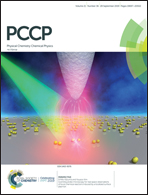Structural and electronic properties of small lithium peroxide clusters in view of the charge process in Li–O2 batteries†
Abstract
The Li–O2 battery is an ideal energy storage device due to its highest theoretical energy density; however, its high charge overpotential limits its practical application. Herein, through ab initio calculations, we systematically investigated the structural and electronic properties of small (Li2O2)nm+ (n = 1, m = 0, 1 and n = 2, m = 0, 1, and 2) clusters and calculated the reaction energies of various decomposition reactions. Results show that the (Li2O2)1 monomer has a low spin, whereas the (Li2O2)2 dimer has a high spin. The analysis of bond length, molecular orbitals, and projected density of states reveals that the interaction of O–O is stronger in the cationic cluster than in the neutral one, whereas the interaction of O–Li is weaker in the cationic cluster than in the neutral one; this facilitates the decomposition of cationic lithium peroxide cluster. Furthermore, the calculated reaction energies indicate that the peroxide lithium decomposition preferentially favors two-step reaction over one-step reaction. Finally, the lowest-energy reaction pathway for the decomposition of (Li2O2)2 dimer was predicted to be (Li2O2)2 → Li2O2 → (Li2O2)+ → LiO2 → O2, and the rate-determining step was predicted to be the first step.



 Please wait while we load your content...
Please wait while we load your content...